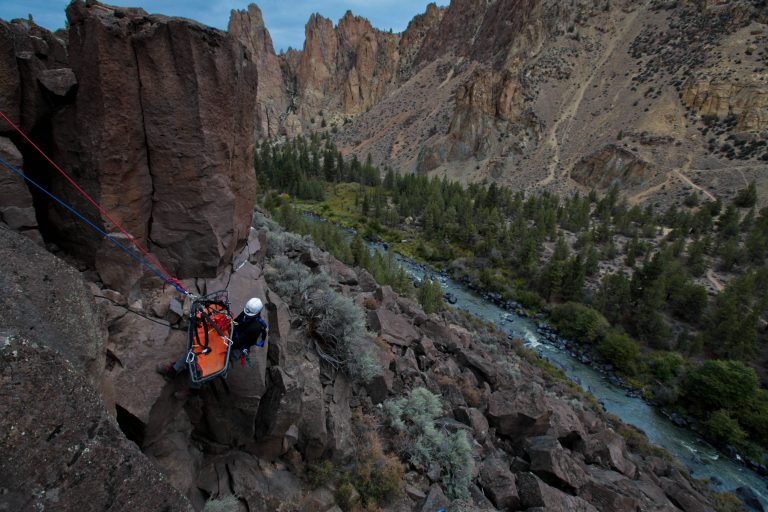Organizing Equipment for Efficient Deployment
Effective organization of rope rescue equipment is essential for streamlined operations, especially in high-pressure scenarios where every second counts. By developing a system for organizing and accessing equipment, rescue teams can enhance their readiness, improve efficiency, and minimize delays.
The Importance of Equipment Organization
The organization of rescue equipment is not just about tidiness; it’s about operational effectiveness. Proper organization allows teams to:
- Save Time: Quickly locate and deploy the necessary tools during emergencies.
- Improve Safety: Reduce the risk of errors caused by disorganized or misplaced equipment.
- Enhance Team Coordination: Ensure all members can identify and access gear seamlessly.
When equipment is well-organized, rescuers can focus on the task at hand rather than searching for tools or improvising under pressure.
Strategies for Organizing Rope Rescue Equipment
To achieve efficient deployment, consider the following strategies:
- Establish Clear Categories
- Group equipment by type (e.g., ropes, anchors, harnesses, pulleys) to simplify identification.
- Separate tools used for specific rescue scenarios, such as high-angle, confined space, or swift water rescues.
- Create Pre-Packaged Kits
- Assemble kits tailored to common rescue operations. For example:
- High-Angle Kit: Static ropes, pulleys, and mechanical advantage systems.
- Confined Space Kit: Low-profile harnesses, compact anchors, and portable tripods.
- Water Rescue Kit: Buoyant ropes, helmets, and waterproof harnesses.
- Assemble kits tailored to common rescue operations. For example:
- Use Labeled Storage Solutions
- Opt for durable, weather-resistant containers or bags with clear labels.
- Implement color-coding systems for quick visual identification (e.g., red for high-angle, blue for water rescue).
- Designate Storage Areas
- Assign specific storage locations for each type of equipment.
- Ensure frequently used items are easily accessible, while less critical tools are stored securely.
- Integrate Checklists
- Develop detailed checklists for packing, deploying, and inventorying equipment.
- Review and update checklists after each operation to reflect lessons learned.
Deploying Equipment on Rescue Scenes
Efficient deployment begins with a systematic approach to gear retrieval and staging. Follow these best practices:
- Conduct a Pre-Deployment Briefing
- Review the operation plan and required equipment with the team.
- Assign roles for retrieving and setting up specific tools.
- Stage Equipment Strategically
- Position gear close to the rescue site but outside the hazard zone.
- Arrange items in order of deployment to avoid unnecessary delays.
- Streamline Retrieval
- Use gear bags or backpacks for easy transport to the rescue scene.
- Avoid overloading any single team member to maintain mobility.
- Adapt to Changing Conditions
- Be prepared to reorganize equipment as the rescue progresses.
- Keep contingency gear on standby for unforeseen challenges.
Regular Review and Updates
To maintain an efficient organizational system, rescue teams must regularly assess and refine their approach. Key steps include:
- Inventory Checks: Conduct routine inventories to account for all equipment and identify missing or damaged items.
- Feedback Collection: Solicit input from team members on the effectiveness of current organization methods.
- Post-Operation Reviews: Evaluate the deployment process after each rescue to identify areas for improvement.
Common Challenges in Equipment Organization
Despite best efforts, rescue teams may encounter organizational challenges, such as:
- Limited Storage Space: Optimize available space with stackable containers, vertical racks, or wall-mounted hooks.
- Frequent Gear Turnover: Implement a robust logging system to track the use and maintenance of each item.
- Varying Team Sizes: Tailor organization systems to accommodate both small and large teams, ensuring scalability.
Conclusion: A System That Saves Lives
Effective equipment organization is a cornerstone of successful rope rescue operations. By implementing a thoughtful system for storage, categorization, and deployment, teams can reduce response times, improve safety, and ensure mission readiness. Remember, in rescue operations, every second matters, and well-organized gear can be the difference between life and death.
Links Included:
- Efficient Rope Rescue Gear Storage Tips
- Rope Rescue Equipment Selection and Maintenance
- High-Angle Rescue Kit Essentials
Peace on your Days
Lance










